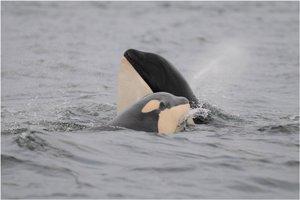- Blog
- Sustainable Economic Systems
- Naval activity imperils whales
Naval activity imperils whales

Donate Now!
Your contribution will benefit Friends of the Earth.
Stay Informed
Thanks for your interest in Friends of the Earth. You can find information about us and get in touch the following ways:
Fred Felleman, Friends of the Earth’s Northwest consultant, stood on the dock in Everett, WA, this past February capturing evidence of the U.S. Navy’s active sonar use with a hydrophone. But the sonar gradually became so loud it could be heard standing at the dock without any special equipment. He was out on the dock that day because earlier in the month, on February 11, a female orca identified as L-112 was discovered washed up on Long Beach, WA. While Fred’s evidence doesn’t prove that sonar or an explosion was the cause of L-112’s death, navy training exercises that involve the use of sonar and explosives have been associated with cases of whales being injured or deafened in the past.
Fred has been studying orcas since 1980, and for the past several years he has been at the forefront of a fight in the Northwest to protect critical habitats from the U.S. and Canadian navies’ training and operational exercises.
The inland waterways of Puget Sound and the Strait of Juan de Fuca in Washington State and British Columbia, known as the Salish Sea are home to the Southern Resident killer whale. These orcas are critically endangered; just 86 individual whales comprise the three family groups or pods known as J, K and L pods.
These amazing marine mammals are at risk from any number of threats: dwindling food sources, particularly Chinook salmon, which itself is a threatened species; accumulating contaminants such as PCBs and PBDEs found in their in their fatty prey; and escalating risk of oil spills and noise pollution from ships that interferes with the orca’s echolocation method of detecting fish. On top off all this, orcas have to contend with the literally deafening and sometimes fatal sound of Navy sonar and explosives.
The U.S. Navy’s Northwest Training Range Complex stretches from the inland marine waters of Puget Sound, west to the outer coast of Washington, and south to Northern California, encompassing more than 126,000 square nautical miles — an area nearly equivalent in size to the state of California. Despite this vast range, there are currently very few guidelines for when and where the navies can conduct training exercises.

Friends of the Earth is demanding that the Navy put in place restrictions on the timing and location of sonar exercises and use of explosives, in order to protect sensitive marine life, before it ramps up training off the Washington, Oregon and California coasts. We have joined several other environmental groups and tribes in suing the federal government for its failure to adequately protect the whales from sonar and explosive use. In addition, Friends of the Earth has joined a group of 20 scientists that represent much of the Northwest killer whale research community, including Fred Felleman, with a simple message for both the U.S. and Canadian navies: keep life threatening high-intensity sonar and explosives out of orca critical habitat.
Scientists are still trying to determine what caused L-112’s death and we will post updates on the outcome of the investigation into L-112’s death on our blog at www.foe.org/news/archives/2012-05-naval-activity-imperils-whales.
Endangered orcas display their vulnerability to Canadian naval activities in the San Juan Islands near Boundary Pass
Photo Credit: Fred Felleman, NW Consultant, Friends of the Earth
L-112 shows her characteristic tight family bond with her mother L-86 near the San Juan Islands
Photo Credit: Ken Balcomb, Center for Whale Research
